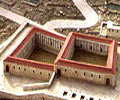A Jesus "miracle" explored - A Healing at Bethesda?
Miracles - an Introduction
Jesus steals the magic of Asclepius!
Pagan sanctuary gets a Christian makeover!
During the second Jewish war of 132-135 the wrecked city of Jerusalem saw no major conflicts, although the rebel leader Simon ben Kosiba is said to have offered sacrifices at the site of the destroyed temple. Post-war a new Roman city was built on ruins which had stood abandoned for sixty years. This new colony – Aelia Capitolina – was named by Emperor Hadrian for the gods of Rome (Jupiter, Juno and Minerva) and himself (Pulbius Aelius Hadrianus).
The 2nd century evangelists, hustling for position in a world full of gods and convinced that they alone possessed divine truth, set out to put the rival cult out of business. It was “useful”, therefore, for gospeller John to have his divine hero perform superior magic at the very spot that the god Asclepius worked his wonders. With the triumph of Constantine this shrine to a pagan god – and the rudimentary hospital that it provided – were soon reduced to ruin.
Miracle, Magic or Myth?
“And when the Devil brings forward Asclepius as the raiser of the dead and healer of all diseases, may I not say that in this matter likewise he has imitated the prophecies about Christ?”
Why would a divine being go to a pagan healing centre to perform a healing? But in the gospel yarn that is precisely what Jesus does. Unlike in a dozen or so other Jesus “healings”, there is NO prayer, NO touching of hands – a word from the godman is all that is required to end the chronic illness. The punch line about picking up his bed and walking is taken from Mark 2.12.
“For an angel went down at a certain season into the pool, and troubled the water: whosoever then first after the troubling of the water stepped in was made whole of whatsoever disease he had.” – John 5.4.
“Afterward Jesus findeth him in the temple, and said unto him,
Behold, thou art made whole: sin no more, lest a worse thing come unto thee.”
– John, 5.14.
The priestly purpose of the “healing miracle” of Bethesda was to have Jesus neutralise the ancient magic of Asclepius.
Those "five porches"
Archaeology does not support the claim made by Christian apologists (following the lead of 3rd century Origen) that “porticos” surrounded the two reservoirs. By supposing that another ran across the central “dam”, they derive the “five porches” referred to by John.
Dumbing-down

The smaller pools of the Asclepion – NOT the deep reservoirs – served for healing. The pagan sanctuary was first destroyed and then built over.

"Porches" at the Asclepieion of Cos, Greece.
Spit, Touch and Faith – The Miracles of Jesus
Curiously, the blind are always male, never female. Another indication that the Jesus yarn is pious fiction not historical fact?
Sources:
- Robert Gordon, Holy Land, Holy City (Paternoster, 2004)
- H. J. Richards, Pilgrim to the Holy Land (McCrimmons,1985)
- S. Gibson, J. Taylor, Beneath the Church of the Holy Sepulchre (Palestine Exploration Fund, 1994)
- W. Keller, The Bible as History (Hodder and Stoughton, 1969)
- Joan Taylor, Christians and Holy Places: The Myth of Jewish-Christian Origins (Clarendon, 1993)
- Martin Biddle, The Tomb of Christ (Sutton, 1999)
- Jerome Murphy-O’Connor, The Holy Land (Oxford, 1986)
- Karen Armstrong, A History of Jerusalem (HarperCollins, 1997)
Related Articles:

Jesus miracle site?
Jesus miracle site?


Jesus miracle site?
Limited excavation around the Church of St Anne in 1957 and 1962 revealed the foundation walls of the sanctuary of Asclepius and numerous pools and basins, overlaid by later Byzantine and Crusader churches.
Stirring the water
So popular and widespread was the following of Asclepius that the cult not only had sanctuaries throughout the Greek world but even had a shrine within the shadow of the Jewish Temple.


"Five Porticoes"

Dreamland. Is that five or seven porticoes? Christian apologetics' bizarre and dangerous concept.

How the Asclepieion may have looked, with the sanitaria arranged to provide treatment in the small pools and baths.
